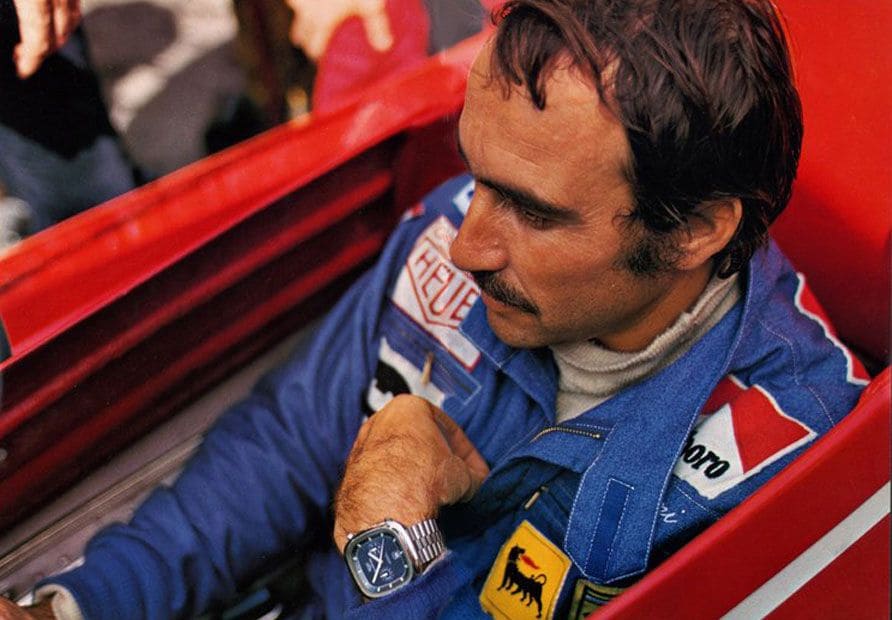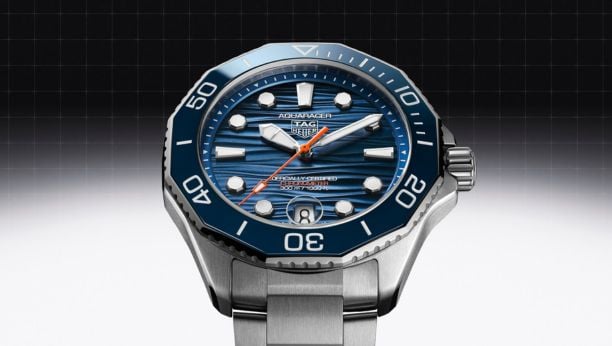VINTAGE COLLECTION
THE HEUER SILVERSTONE
The Silverstone chronograph was introduced in 1974 as the successor of the Monaco, with the new model moderating some of the extreme elements of the Monaco. Still, facing difficult economic and industry conditions, the Silverstone had a limited run, with three colorful models in the 1970s and one model in the mid-1980s. These watches capture the bold style of the 1970s, and have remained popular to this date.
When Heuer introduced the world’s first automatic chronographs, in 1969, the line-up of models consisted of the Autavia, the Carrera and the Monaco. With its outrageous square shape, and a midnight blue dial with white and red accents, the Monaco was Heuer’s avant-garde, unconventional chronograph, a creation of the 1960s that would carry the Heuer flag into the 1970s. The Monaco didn’t achieve the popularity that Heuer had hoped for, so in 1974 introduced the Silverstone chronograph, as its replacement.
Like the Monaco, the Silverstone used a square case, but the new model “walked-back” the most outrageous elements of the Monaco. On the Silverstone, the corners of the case were rounded (rather than squared), the registers were flat and used the same paint as the dial, the sharp edges of the case were softened, with a sculpted top bezel, and the case used a traditional screw-back, in place of the clips and springs used for the Monaco. The Silverstone was the first Heuer chronograph to carry the name of a racetrack, with the Daytona, Monza and Jarama soon to follow.
Unlike most Heuer models of the 1970s, the Silverstone line-up was straight forward – there were three versions with identical cases, bright white hands (with wide luminous inserts) and Calibre 12 movements. All that differed between the three models was the color and finish of the dial and the matching inner bezels.


BLUE SILVERSTONE
The Blue Silverstone (reference 110.313B) features a deep blue dial, with a matte finish, which contrasts with the metallic finish of the inner-bezel. The blue model was featured in advertisements and catalogs and worn by Formula 1 racer Clay Regazzoni.

FUME SILVERSTONE
The “fume” (smoke) model of the Silverstone (reference 110.313F) was the first Heuer chronograph to use this color. Both the dial and inner bezel have a starburst finish, with the colors appearing to change dramatically, depending on the angle and the lighting.

RED SILVERSTONE
In the 1970s, Heuer would produce a broad range of chronographs with bright dials, but only one of them would be red - the Silverstone (reference 110.313R). Both the dial and the inner bezel of this model had a glossy finish.
THE LEMANIA-POWERED SILVERSTONE
With Piaget Group acquiring control of Heuer in 1982, and Nouvelle Lemania taking 20% of the company, it wasn’t long before Heuer moved from the Calibre 12 movement to Lemania movements for its automatic chronographs. The first series of Lemania-powered chronographs (from 1983) had no model names, but soon Heuer began to transition some of its existing models (Carrera and Cortina, for example) to the Lemania 5100 series of movements.
Circa 1985 Heuer introduced a new version of the Silverstone chronograph (reference 510.403), using the Lemania 5100 movement. Other than its use of a massive, television-shaped stainless steel case, the new Silverstone shared little with its Calibre 12 predecessors. The dial was charcoal gray, with bright orange hands for the chronograph hours, minutes and seconds, and white hands for the time of day. The running seconds register was at 9 o’clock, with day and date at 3 o’clock. On later models, the name “Silverstone” was deleted, as Heuer took this approach with other models (for example, the Cortina and Pasadena).

TAG HEUER SILVERSTONE
To mark the 150th of the Heuer brand, in 2010 TAG Heuer produced a new Limited Edition of the Silverstone, with either a blue dial (CAM2110) or a brown dial (CAM2111). With the TAG Heuer Calibre 11 movement (introduced by TAG Heuer for the 40th anniversary of the Monaco), the crown was on the left side of the case, with a 30 minute chronograph recorder at 9 o’clock and running seconds at 3 o’clock. The new Silverstone was limited to 1,860 pieces of each color.



TAG HEUER SILVERSTONE
RED UNIQUE PIECE
The rarest of all the Silverstones was a red model produced in 2010, in connection with the other re-editions, with one sample being produced and sold at auction for the benefit of a charity. This unique watch had the signature of Jack Heuer across the bottom of the dial, above the date window.







